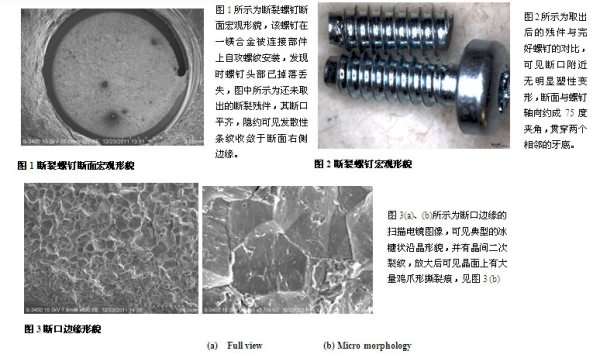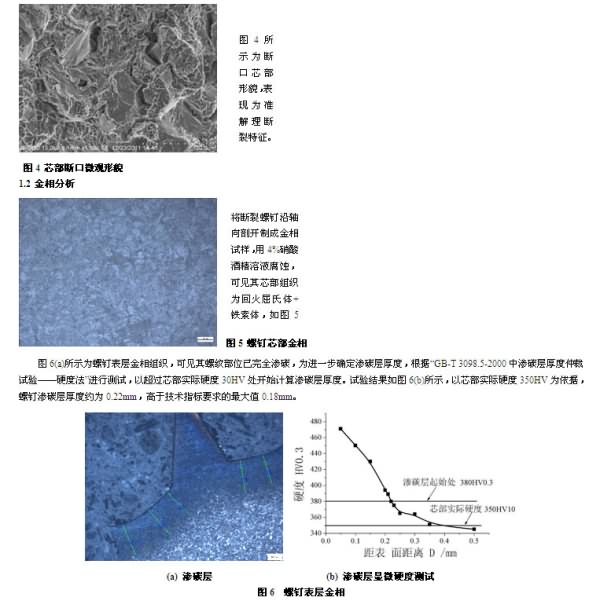Abstract: The fracture causes of a certain type of passenger car steering wheel fixing screws were analyzed by scanning electron microscopy, metallographic examination, microhardness, chemical composition analysis and hydrogen embrittlement preload test. The results show that the fracture property of the screw is hydrogen-induced delayed fracture, which originates from the first base of the screw head. Insufficient hydrogen flooding after electroplating results in a high concentration of hydrogen remaining on the surface of the screw. The concentration of stress on the surface carburized layer and the first tooth constitutes three sensitive factors leading to hydrogen embrittlement.
Automotive fasteners have higher safety and reliability requirements than conventional fasteners. Automotive OEMs often require fasteners from their suppliers to have zero defects because the vehicle is running at high speeds, even An inconspicuous screw break can also cause serious safety accidents. When a passenger car of a certain model was tested, the screw used to fix the steering wheel broke, and the factory asked for the reason for the fracture. The screw is a self-extruding screw with a nominal diameter of 3.5 mm and a material of SAE 1022. The surface is carburized and then electrogalvanized.
1 Physical and chemical testing
1.1 fracture analysis
Figure 1 shows the macroscopic topography of the fracture screw. The screw is self-tapping on a connected part of the magnesium alloy. When the screw head is found, it has been lost and lost. The figure shows the broken parts that have not been removed. The fracture is flush, and the divergent stripes are faintly visible to the right edge of the section.
Macroscopic morphology and fracture edge morphology of self-squeezing screw of automobile steering wheel

Metallographic analysis of automobile steering wheel self-squeezing screw and microhardness test of carburized layer
1.3 Chemical composition analysis
Inductively coupled plasma emission spectroscopy (ICP) was used to analyze the chemical composition of some residual samples. The results are shown in Table 1. The chemical composition is higher than the requirement of 1022 steel in the SAE J430-2001 standard. This may be due to carburization of the screw surface.
Table 1 Chemical composition of broken screws (mass fraction, %)
Tab.1 Chemical composition of the fractured screw (wt. %)
Â
chemical element
C
Si
Mn
P
S
standard regulation
0.17 ~ 0.23
≤0.10
0.70 to 1.00
≤0.030
≤0.035
Detected value
0.28
0.06
0.80
0.016
0.010
1.2 Determination of hydrogen content
Take the fracture sample and the intact sample to measure the hydrogen content. According to the manufacturer, the screw has been heated at 200 °C for 4 hours after electroplating, but the test results show that the hydrogen content of the screw is still At a higher level.
Table 2 Â Screw hydrogen content
Tab.2 Hydrogen content of the screws
Sample
Hydrogen content / ppm
Fracture specimen
12.5
Intact sample
10.0 , 9.5 , 11.3
In order to further verify whether the screw has hydrogen embrittlement tendency, the hydrogen embrittlement preload test was carried out according to GB/T 3098.17-2000. No screw fracture was found after 48 hours of maintenance. However, after careful observation, it was found that many thread parts had broken or generated. The crack is shown in Figure 7(a). When the fracture surface of the thread is enlarged, the fracture surface is characterized by intergranular fracture, there are secondary cracks between the crystals, and there are a large number of chicken-claw tears on the crystal surface, which is a typical hydrogen-brittle fracture morphology, as shown in Fig. 7(b). Shown.

Screw shape after auto-crushing screw of automobile steering wheel
2. Comprehensive analysis
The above analysis results show that the bolt break is flush and has no obvious plastic deformation. The edge of the fracture is a sugar-like shape along the crystal shape. There are a lot of chicken-claw tear lines on the crystal surface; the core is quasi-cleavage morphology, these are hydrogen. Typical characteristics of brittle fracture. At the same time, a higher concentration of hydrogen was also detected in the screw. The test results of the hydrogen embrittlement preload test also indicated that the carburized layer was a hydrogen embrittlement sensitive zone.Hydrogen embrittlement fracture is a common type of failure mechanism of fastener products, which is the failure of parts under the static stress below the yield limit of the material. It is irreversible damage caused by hydrogen infiltration into the metal. It has no signs and is sudden, so the hydrogen embrittlement fracture is extremely destructive. The main factors affecting hydrogen embrittlement are: carbon content of steel, microstructure, strength of steel, hardness and stress. The higher the carbon content of steel, the higher the strength, the higher the hardness, and the higher the stress, the higher the hydrogen embrittlement sensitivity [1]. In this case, the screw undergoes an electroplating process throughout the manufacturing process, causing hydrogen to penetrate into the surface of the screw. Although hydrogen is treated after electroplating, the hydrogen content in the screw is still at a high level, which may be due to surface plating. The escape of internal hydrogen plays a certain hindrance [2,3]. Since hydrogen is not uniformly distributed inside the material, it will be enriched in the microscopic defects and stresses of the material. The first tooth under the head is a part with high stress. Under the action of the load, hydrogen interacts with the local stress. Here, local high concentration enrichment of hydrogen is formed (much higher than the average hydrogen concentration detected); and the high carbon and high hardness of the surface of the screw after carburizing and quenching has high hydrogen embrittlement sensitivity, resulting in hydrogen induced The cracks sprout in the carburized layer and expand inward, eventually causing the screw to break.
3. Conclusion
The fracture property of the screw is hydrogen-induced delayed fracture. The crack originates from the carburized layer. The insufficient hydrogen drive and the excessive thickness of the carburized layer are the root causes of the hydrogen-brittle fracture of the screw. It is recommended that the manufacturer not properly affect the quality of the coating. Increase the hydrogen flooding temperature and extend the holding time. The thickness of the carburized layer should be controlled to the lower limit specified by the standard.
- A strong and hearty exotic hardwood that will last for years
- Easy to install and finishes with a high, natural polish
- Highly durable and resistant to insects
- Tigerwood hardwood flooring has a Janka Hardness of 2170
KelaiWood , https://www.kelaiwoodens.com